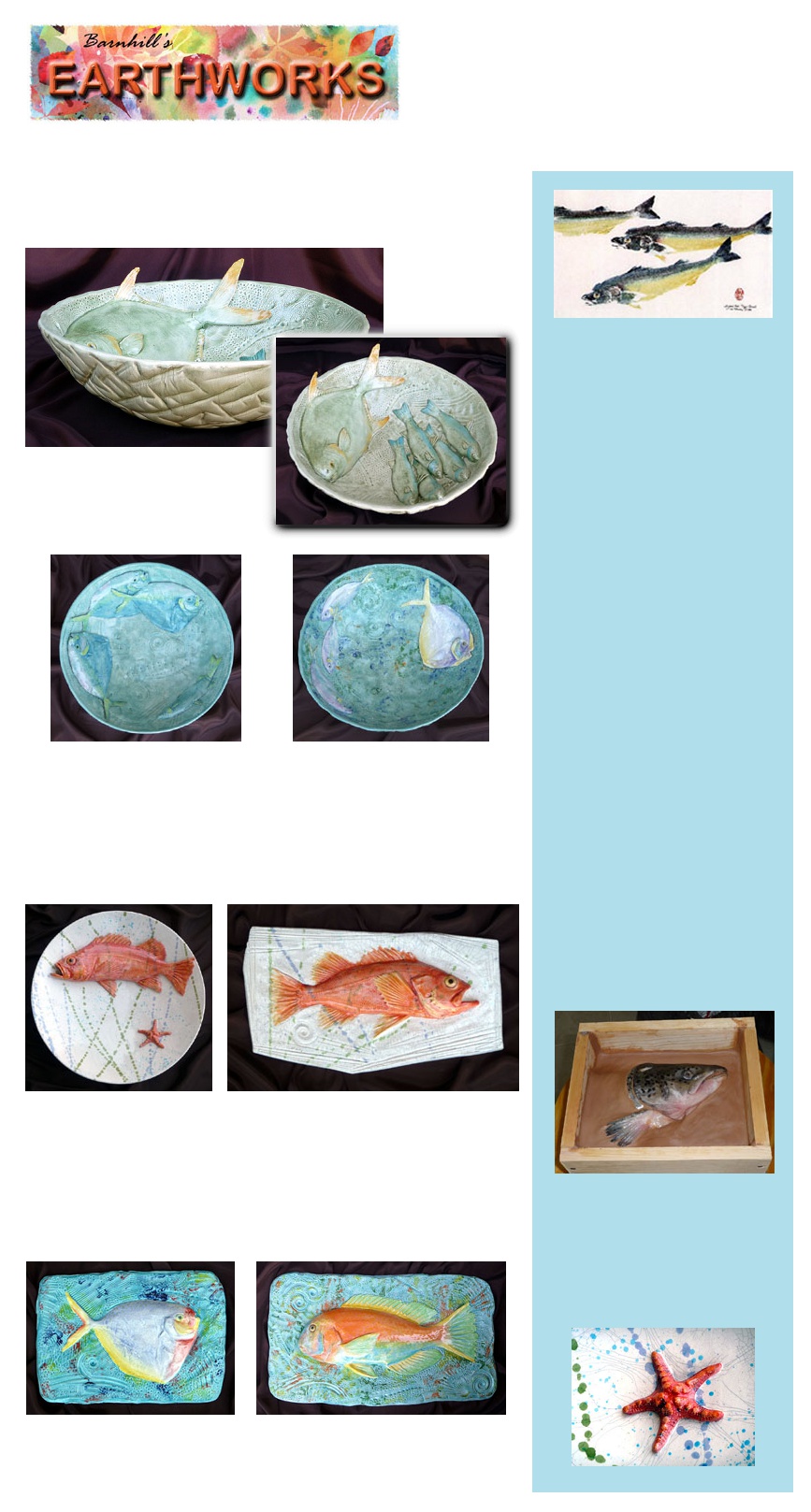


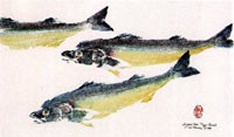
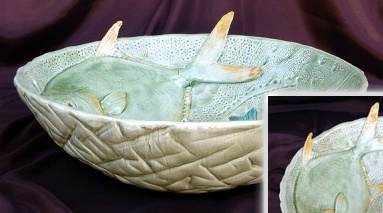

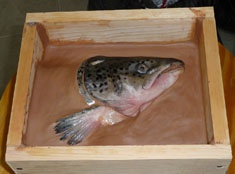
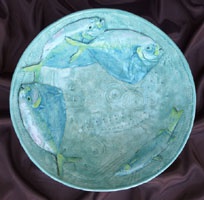
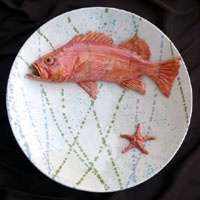



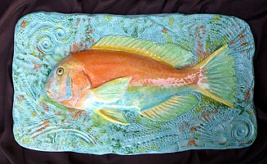
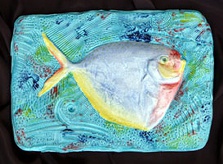

Original Clay Sculpture
Gyotaku Yakimono
gyo=fish, taku=rubbing
yakimono= fired thing or pottery
gyo=fish, taku=rubbing
yakimono= fired thing or pottery
Gyotaku History
This form of printmaking originated in Japan in the early 1800’s. Japanese fishermen would record their catch and document the size and types of fish they caugh. Some fish were revered and they would take rubbings of these fish and then return them to the sea. Japanese fishermen took newsprint, ink and brushes out to sea with them to create the prints that were brought back and displayed in their homes or kept in journals to be used as conversation pieces and to relate proud and heroic stories of the catch. Hence, the Japanese have no “big fish” tales!
Gyotaku Today
With the addition of artistic elements and personal style, Gyotaku has developed into an art form with the intention of creating fish prints solely for their simplistic beauty and decorative display. Modern Gyotaku artists use a variety of ink colors and quality cotton fiber and rice papers to create their lively compositions of sea life.
Mary Barnhill’s Gyotaku Yakimono
My inspiration for this series of “fish pots” came from my fascination with this unusual art form. I wondered if the same process of “fish rubbing” would translate into a three dimensional form with the medium of clay. I experimented with a salmon head (below) and a whole-body rainbow trout creating simple “press molds” out of plaster. My first Gyotaku Yakimono piece was an Asian style trout tea pot. Success! I have continued to experiment with different presentations of the fish and a wide variety of glazing techniques.
This form of printmaking originated in Japan in the early 1800’s. Japanese fishermen would record their catch and document the size and types of fish they caugh. Some fish were revered and they would take rubbings of these fish and then return them to the sea. Japanese fishermen took newsprint, ink and brushes out to sea with them to create the prints that were brought back and displayed in their homes or kept in journals to be used as conversation pieces and to relate proud and heroic stories of the catch. Hence, the Japanese have no “big fish” tales!
Gyotaku Today
With the addition of artistic elements and personal style, Gyotaku has developed into an art form with the intention of creating fish prints solely for their simplistic beauty and decorative display. Modern Gyotaku artists use a variety of ink colors and quality cotton fiber and rice papers to create their lively compositions of sea life.
Mary Barnhill’s Gyotaku Yakimono
My inspiration for this series of “fish pots” came from my fascination with this unusual art form. I wondered if the same process of “fish rubbing” would translate into a three dimensional form with the medium of clay. I experimented with a salmon head (below) and a whole-body rainbow trout creating simple “press molds” out of plaster. My first Gyotaku Yakimono piece was an Asian style trout tea pot. Success! I have continued to experiment with different presentations of the fish and a wide variety of glazing techniques.
Golden Pampano
wtih Baby Mullet
Fisherman’s Catch Bowls
I make these unusual fish print bowls by pressing a large slab of clay into a wire basket with a random pattern. The texture gives the feeling of a floating fisherman’s net. Fish that I cast from my own molds are placed swimming around the circular interior. The pieces are glazed in watery aqua or sea green colors with the fish highlighted in complementary or harmonious tones.
I make these unusual fish print bowls by pressing a large slab of clay into a wire basket with a random pattern. The texture gives the feeling of a floating fisherman’s net. Fish that I cast from my own molds are placed swimming around the circular interior. The pieces are glazed in watery aqua or sea green colors with the fish highlighted in complementary or harmonious tones.
To my knowledge, there is no previously
established art form combining the art
of “fish rubbing” with the art of pottery
making. In a search on the internet,
multiple combinations of these words
used together in either Japanese or
English produced zero results.
Gyotaku Crackleware
For an authentically Asian aesthetic, I feature my fish castings in bright colors on a white crackle background. The cracks are darkened with an antiquing solution. For a watery accent I use a Japanese sumi brush to splash glaze colors across the pieces. (Crackleware is strictly decorative and not intended for food use.)
For an authentically Asian aesthetic, I feature my fish castings in bright colors on a white crackle background. The cracks are darkened with an antiquing solution. For a watery accent I use a Japanese sumi brush to splash glaze colors across the pieces. (Crackleware is strictly decorative and not intended for food use.)
Three Moonfish and
a Baby Mullet
Small Red and Starfish
Small Red Plaque
Moonfish and
Yellow Stripe Trevally
Yellow Stripe Trevally
Ocean Floor Gyotaku
These pieces are made with one continuous slab of clay that is first pressed into the fish mold. Then I stamp the clay surrounding the fish with sea shells, coral or anemone to create a texture that conjures images of the ocean floor. Like the colors you would see diving in a coral reef, the glazes are vivid and lifelike. (Platters and trays are non-toxic and food safe. Hand-wash only.)
These pieces are made with one continuous slab of clay that is first pressed into the fish mold. Then I stamp the clay surrounding the fish with sea shells, coral or anemone to create a texture that conjures images of the ocean floor. Like the colors you would see diving in a coral reef, the glazes are vivid and lifelike. (Platters and trays are non-toxic and food safe. Hand-wash only.)
Moonfish Plaque
Parrotfish Plaque




